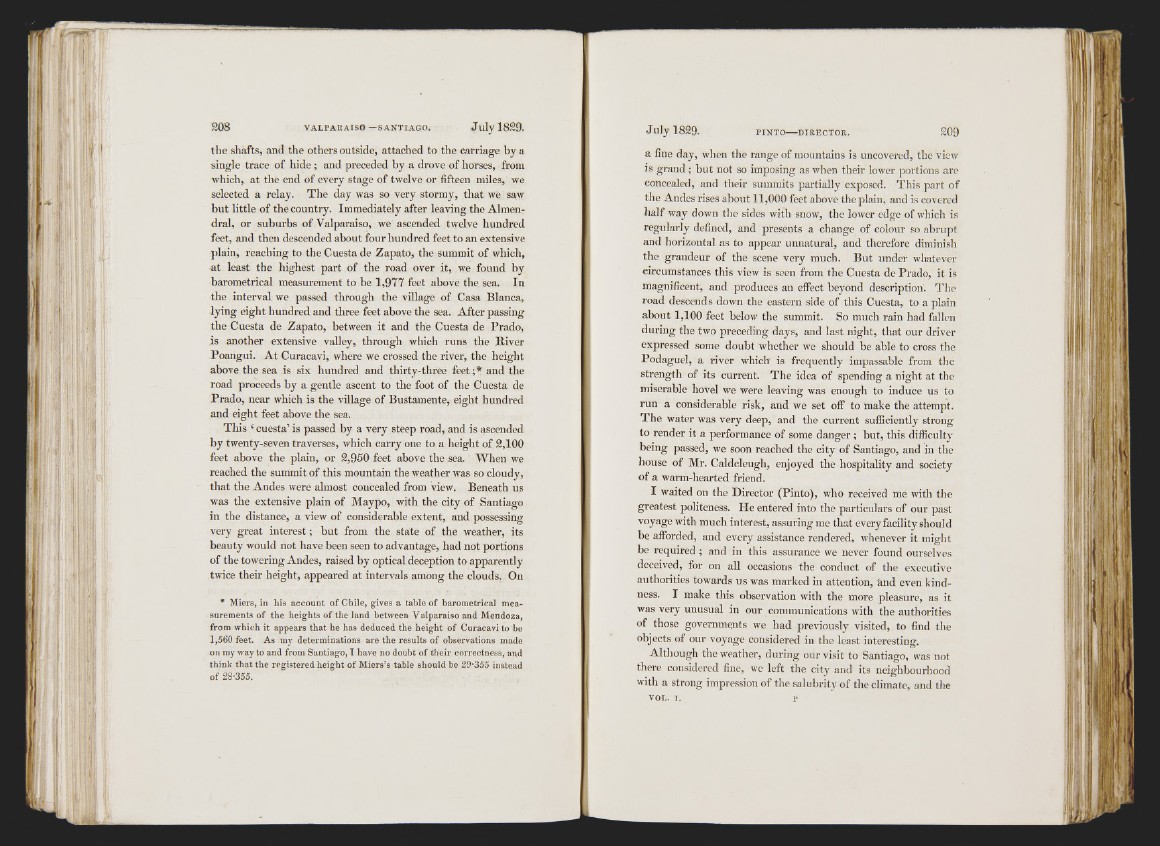
I r . ,
'li ^ ■ ì
^ . ( h
‘ ir
- i;
t f,V{
u i i
Ai'.
Ipi
-■■ 'i l ! .
7:-q; ^ , : 4
' ^ ; | ■
,1; :
• r ' 4
):
H
the shafts, and the others outside, attached to the carriage by a
single trace of hide ; and preceded by a drove of horses, from
which, at the end of every stage of twelve or fifteen miles, we
selected a relay. The day was so very stormy, that we saw
but little of the country. Immediately after leaving the Almen-
dral, or suburbs of Valparaiso, we ascended twelve hundred
feet, and then descended about four hundred feet to an extensive
jilain, reaching to the Cuesta de Zapato, the summit of which,
at least the highest part of the road over it, we found by
barometrical measurement to be 1,977 feet above the sea. In
the interval we passed through the village of Casa Blanca,
lying eight hundred and three feet above the sea. After passing
the Cuesta de Zapato, between it and the Cuesta de Prado,
is another extensive valley, through which runs the River
Poangui. At Curacavi, where we crossed the river, the height
above the sea is six hundred and thirty-three feet;* and the
road proceeds by a gentle ascent to the foot of the Cuesta de
Prado, near which is the village of Bustamente, eight hundred
and eight feet above the sea.
This ‘ cuesta’ is passed by a very steep road, and is ascended
by twenty-seven traverses, which carry one to a height of 2,100
feet above the plain, or 2,950 feet above the sea. When we
reached the summit of this mountain the weather was so cloudy,
that the Andes were almost concealed from view. Beneath us
was the extensive plain of Maypo, with the city of Santiago
in the distance, a view of considerable extent, and possessing
very great interest; but from the state of the weather, its
beauty would not have been seen to advantage, had not portions
of the towering Andes, raised by optical deception to apparently
twice their height, appeared at intervals among the clouds. On
* Miers, in his account of C hile, gives a table of barometrical mea-
surements of the heights of the land between Valparaiso and Mendoza,
from which it appears th a t he has deduced the height of Curacavi to be
1,560 feet. As my determinations are the results of observations made
on my way to and from Santiago, T have no doubt of the ir correctness, and
think th a t the registered h eight of M iers’s table should be 29*355 instead
of 28*355.
a fine day, when the range of mountains is uncovered, tho view
is grand ; but not so imposing as when their lower portions are
concealed, and their summits partially exposed. This part of
the Andes rises about 11,000 feet above the plain, and is covered
half way down the sides with snow, the lower edge of which is
regularly defined, and presents a change of colour so abrupt
and horizontal as to appear unnatural, and therefore diminisli
the grandeur of the scene very much. But under whatever
circumstances this view is seen from the Cuesta de Prado, it is
magnificent, and produces an effect beyond description. The
road descends down the eastern side of this Cuesta, to a plain
about 1,100 feet below the summit. So much rain had fallen
during tlie two preceding days, and last night, that our driver
expressed some doubt whether we should be able to cross the
Podaguel, a river which is frequently impassable from the
strength of its current. The idea of spending a night at the
miserable hovel we were leaving was enough to induce us to
run a considerable risk, and we set off to make the attempt.
The water was very deep, and the current sufficiently strong
to render it a performance of some danger ; but, this difficulty
being passed, we soon reached the city of Santiago, and in the
house of Mr. Caldcleugh, enjoyed the hospitality and society
of a warm-hearted friend.
I waited on the Director (Pinto), who received me with the
greatest politeness. He entered into the particulars of our past
voyage with much interest, assuring me that every facility should
be afforded, and every assistance rendered, whenever it might
be required ; and in this assurance we never found ourselves
deceived, for on all occasions the conduct of the executive
authorities towards us was marked in attention, 'and even kindness.
I make this observation with tlie more pleasure, as it
was very unusual in our communications with the authorities
of those governments we had previously visited, to find the
objects of our voyage considered in the least interesting.
Although the weather, during our visit to Santiago, was not
there considered fine, wc loft the city and its neighbourhood
witli a strong impression of the salubi-ity of the climate, and the
l|-
i ii
VOL. I.